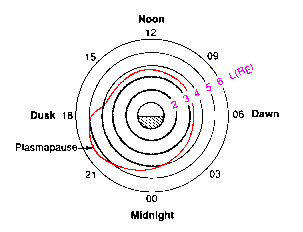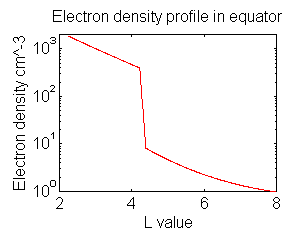 Plasmasphere and
plasmapause
Plasmasphere and
plasmapause Plasmasphere and
plasmapause
Plasmasphere and
plasmapausespaceweb@oulu.fi - last update: 4 January 1999, 1630 UT (RR)
The plasma in the inner magnetosphere co-rotates with the Earth. As a consequence, the ionospheric plasma at mid-latitudes can expand upward along the magnetic field lines and fill them until the plasma gas pressure is equalized along the entire field line. The plasma region above the ionosphere on such closed magnetic field lines is called the plasmasphere. In fact, the plasmasphere can be considered as an extension of the ionosphere, for there is no clear distinction between them. The outer boundary of the Earth-encircling plasma is called the plasmapause. In the first approximation, the plasmasphere lies just inside the ring current and the plasma sheet field lines.
The discovery of the whistler waves provided the first evidence for this high density plasma region. Their analysis revealed also the existence of the plasmapause (Carpenter, 1963). As first suggested by Nishida (1966), the plasma density inside the plasmasphere is significantly higher than outside because field lines at higher latitudes are convected to the magnetopause and are thus open to the interplanetary medium (where the ionospheric supplied plasma is lost).
 |
 |
| Left: The shape of the plasmasphere in the equatorial plane (note the bulge region). Right: A model (Carpenter and Anderson, 1992) calculation of the radial density gradient at the plasmapause. | |
One feature of the plasmasphere is the formation of detached plasma regions in the afternoon sector which can be either detached clouds (Chappell, 1974) or filamentary extensions of the bulge (tails or streamers, Chen and Grebowsky, 1974). They are most likely results of changing electric field (e.g., Grebowsky, 1970). Horwitz et al. (1990) have investigated the possible plasmaspheric density profiles, and classified them in several categories:
The activity dependance of the plasmapause position can be estimated by equating the competing convection (cross-tail) and co-rotation electric fields. The latter field, pointing Earthward in the equatorial plane, is responsible for the co-rotation of the plasma inside the plasmasphere (ExB direction). Co-rotation field is important in the inner magnetosphere because the large scale convection electric field cannot penetrate into it. This shielding is due to zonal charge separation as the plasma sheet electrons drift dawnward and protons duskward around the Earth, and it is related to the Region 2 field-aligned currents. Note that it is not possible to shield the plasmasphere completely from the convection electric field, since there are no steady state conditions. The penetration of the convection field into the plasmasphere reduces the zonal flow in the evening sector, and enhances it in the morning sector (Maynard et al., 1983).
During increasing activity, the stronger cross-tail electric field pushes the plasmapause closer to the Earth, and peeles off the outer layers of the old plasmasphere. It has been argued that the plasmasphere may be an important source for the magnetospheric plasma (Elphic et al., 1997; see also superdense plasma sheet). Conversely, during decreasing activity, plasmapause moves outward, and a slow refilling process from the dayside F-region ionosphere begins. The details of this refilling are not quite understood yet (e.g., if shock formation is taking place, see Horwitz and Singh, 1991).
During the refilling process, the new plasmasphere is forming above the recently enhanced ring current, increasing the Coulomb collisions between ring current ions (mostly oxygen at lower energies) with the cold plasma. This may be the energy source of the subauroral SAR arcs, which can be explained by heat conduction from the magnetosphere. More generally, electron temperature could be used as a plasmapause location indicator at low altitudes, since the heat capacity and the conductivity are greater on the dense plasmaspheric field lines.
The source of the structured, storm recovery phase Pc 1 pulsations is located in the ring current region near the plasmapause. At higher frequencies (few hundreds hertz) plasmaspheric hiss (Thorne et al., 1973) is observed just inside the plasmapause.
See also: